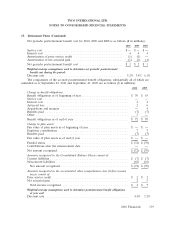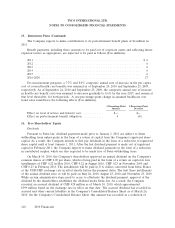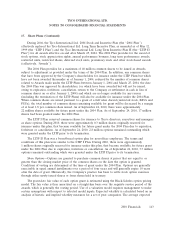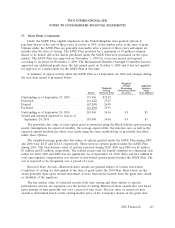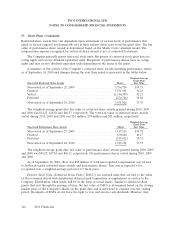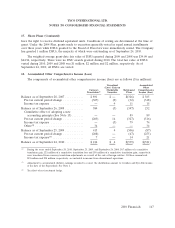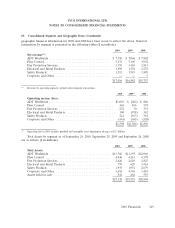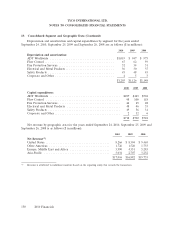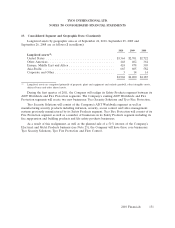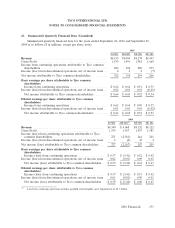ADT 2010 Annual Report Download - page 231
Download and view the complete annual report
Please find page 231 of the 2010 ADT annual report below. You can navigate through the pages in the report by either clicking on the pages listed below, or by using the keyword search tool below to find specific information within the annual report.TYCO INTERNATIONAL LTD.
NOTES TO CONSOLIDATED FINANCIAL STATEMENTS
17. Share Plans (Continued)
During 2004, the Tyco International Ltd. 2004 Stock and Incentive Plan (the ‘‘2004 Plan’’)
effectively replaced the Tyco International Ltd. Long Term Incentive Plan, as amended as of May 12,
1999 (the ‘‘LTIP I Plan’’) and the Tyco International Ltd. Long Term Incentive Plan II (the ‘‘LTIP II
Plan’’) for all awards effective on and after March 25, 2004. The 2004 Plan provides for the award of
stock options, stock appreciation rights, annual performance bonuses, long term performance awards,
restricted units, restricted shares, deferred stock units, promissory stock and other stock-based awards
(collectively, ‘‘Awards’’).
The 2004 Plan provides for a maximum of 40 million common shares to be issued as Awards,
subject to adjustment as provided under the terms of the 2004 Plan. In addition, any common shares
that have been approved by the Company’s shareholders for issuance under the LTIP Plans but which
have not been awarded thereunder as of January 1, 2004, reduced by the number of common shares
related to Awards made under the LTIP Plans between January 1, 2004 and March 25, 2004, the date
the 2004 Plan was approved by shareholders, (or which have been awarded but will not be issued,
owing to expiration, forfeiture, cancellation, return to the Company or settlement in cash in lieu of
common shares on or after January 1, 2004) and which are no longer available for any reason
(including the termination of the LTIP Plans) will also be available for issuance under the 2004 Plan.
When common shares are issued pursuant to a grant of a full value Award (restricted stock, RSUs and
PSUs), the total number of common shares remaining available for grant will be decreased by a margin
of at least 1.8 per common share issued. As of September 24, 2010, there were approximately
22 million shares available for future grant under the 2004 Plan. As of September 24, 2010, 17 million
shares had been granted under the 2004 Plan.
The LTIP I Plan reserved common shares for issuance to Tyco’s directors, executives and managers
as share options. During 2010, there were approximately 0.3 million shares originally reserved for
issuance under this plan, that became available for future grant under the 2004 Plan due to expiration,
forfeiture or cancellation. As of September 24, 2010, 2.8 million options remained outstanding which
were granted under the LTIP prior to its termination.
The LTIP II Plan was a broad-based option plan for non-officer employees. The terms and
conditions of this plan were similar to the LTIP I Plan. During 2010, there were approximately
1 million shares originally reserved for issuance under this plan, that became available for future grant
under the 2004 Plan due to expiration, forfeiture or cancellation. As of September 24, 2010, 3.3 million
options remained outstanding which were granted under the LTIP II prior to its termination.
Share Options—Options are granted to purchase common shares at prices that are equal to or
greater than the closing market price of the common shares on the date the option is granted.
Conditions of vesting are determined at the time of grant under the 2004 Plan. Options are generally
exercisable in equal annual installments over a period of four years and will generally expire 10 years
after the date of grant. Historically, the Company’s practice has been to settle stock option exercises
through either newly issued shares or from shares held in treasury.
The grant-date fair value of each option grant is estimated using the Black-Scholes option pricing
model. The fair value is then amortized on a straight-line basis over the requisite service period of the
awards, which is generally the vesting period. Use of a valuation model requires management to make
certain assumptions with respect to selected model inputs. Expected volatility is calculated based on an
analysis of historic and implied volatility measures for a set of peer companies. The average expected
2010 Financials 143








